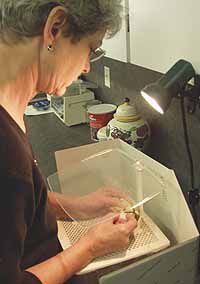| Nan Coonrod works at one of the many machines in the work area of the shop. |
Most people look at glass and see right through it.
Nan Coonrod looks and glass and only sees possibilities.
After majoring in art in college and working with all kinds of mediums she just couldn’t find what she was completely comfortable with. Then one day she attended a demonstration on using glass to create beauty. In less than 10 minutes she was hooked and the addiction has lasted for almost two decades.
Today she owns and runs Classy Glass on Helper’s historic Main Street. And the beauty of what is in the shop almost flows out onto the sidewalk.
“I have seen people from out of town driving down Main Street just looking around and suddenly they rubberneck as they see my shop,” says Coonrod. “Soon they have turned around and are in here looking at everything and wondering what I am doing here.”
What she is doing is running a business where there is never a dull moment. If she, and her friend and associate Pat Weaver aren’t teaching someone to make glass beauty then they are making it themselves.
For years before opening the shop in the mid-1990’s she had a workshop in the basement of her and her husband Mel’s home. Then one day he and she decided she needed to get her priorities straight, set a designated spot where she could do her work and open a shop. They purchased the building in Helper and opened up.
Her work no longer was scattered all over their house; now it was in one spot. But it still hasn’t been easy.
| Lamps, like the ones displayed in the front window of Classy Glass are Nan Coonrod’s passion. |
“Without Mel’s support I could have never done this,” she says. “He supports this shop in it’s lean times. This is a spurty business.”
Coonrod teaches classes on glass, mostly for beginners. She used to do it once a week but found that concentrated classes over a couple of days were much more effective for learning, and for business.
“About two of every six people who take the classes stick with it,” she says. “Sometimes they take it and then later come back to it.”
She says people from the Wasatch Front are particularly attracted to her shop in the little old railroad town.
“They come for the weekend, stay overnight and love the classes and the town,” she says. “It’s an intensive training that they don’t forget as they would week to week, an hour or two at a time. The atmosphere in Helper is part of that.”
But while teaching is an important part of the business, so is her passion: lamps. It is obvious, the front of the shop window is filled with them.
“I find old lamp bases in various places such as second hand stores, and then I take off the shades and create glass ones,” she states as she walks along a counter full of brass, wood and glass bases. “They are simple in design and gorgeous to look at. We use the copper foil method for them because it allows elaborate designs.”
Certainly no one can argue with that. What would glass be without light?
“The lighting source in the lamp is important,” she states. “Incandescent gives off a different light than fluorescent, and so on. The glass has to be right.”
The equipment in the shop varies from grinding machines to various sizes of kilns. However one of the most interesting machines is also one of the most simple; a torch mounted to heat glass and make jewelry.
| Once the burner is lit, glass rods and used are worked under the heat of the flame until it beads up into a ball. To make designs other heated glass is dripped onto the figure, giving it layers. |
Coonrod can fire it up and within a few minutes multicolored and multi-designed beads show up all over the table, almost by magic.
As she works she uses unfamiliar words to rookie ears; fused glass, slump glass, cabochons, foiling. The list goes on and on.
She builds many kinds of things to sell in her shop including bowls and plates, music boxes and figures.
And unlike the familiar saying, she also does windows. Stained glass windows to be exact.
“I have done some big windows and I have done a number of windows for cupboards,” she says.
And right now she is doing a project very close to her heart.
On the new Rio Theatre just down Main Street from her shop there are some thin long windows that can only be seen from the east side of the building. Right now they have nothing in them. Soon however, she will be up there on a lift truck installing long strips of colored glass in various shapes.
“It’s interesting where they put those windows. They are in the wing of the stage where most theatre people don’t want light,” she says. “But there they are. The city asked me a few years ago to put some type of stained glass in but it just wasn’t time. Now it is.”
Once the block glass is put in, it will be a beautiful and unique surprise to anyone who notices them.
Just like that little shop across the city hall in downtown Helper.

